Sometimes there’s no avoiding bad timing. Since paleontology is an ever-shifting field of scientific understanding, any artistic or commercial renditions of prehistoric life risk becoming obsolete at the drop of a new find. Such was the case for Safari Ltd., who announced the release of a new Dilophosaurus model for 2020 to replace the previous Wild Safari version – only for a brand-new paper to drop later that same year, providing a new, thorough analysis of all known Dilophosaurus fossils and providing new insight into the Early Jurassic predator’s life appearance. This isn’t the first time a dinosaur toy has been rendered obsolete shortly out of the gate, and it’s almost certainly not the last – so bearing in mind that our understanding of Dilophosaurus has now changed in various details, how does Safari’s latest model hold up, albeit as a pre-2020 depiction?
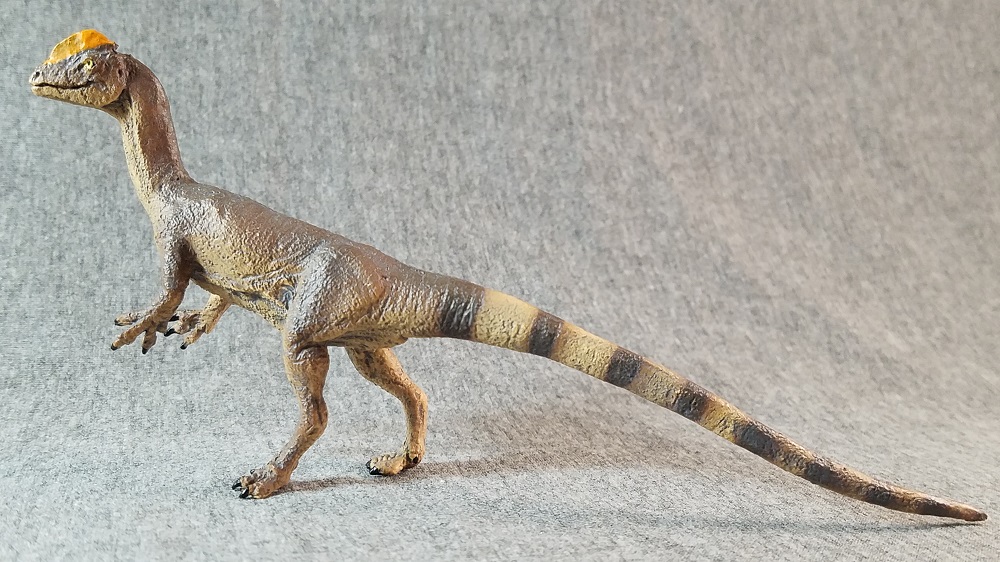
The Wild Safari Prehistoric World Dilophosaurus is on the smaller side of dino replicas, measuring roughly 17 cm (6.75 inches) long from nose to tail tip – not accounting for curvature in the neck or tail – placing the figure at about 1:40 scale for the largest known fossil specimens, or about 1:35 compared to the holotype fossil. The figure is posed mid-step, with head raised and body tilted back, as if on alert. The model appears lively without resorting to a more typical open-mouthed action pose often seen with theropods, which is a welcome choice that feels a little more natural. The angled posture of the figure also allows the model to cheat balancing with the classic tripod stance of the feet and tail tip – although my own figure still has stability issues due to the feet not resting squarely. A little treatment with hot water or a blow dryer can improve the figure’s stability; it has the potential to balance without the tail entirely, at least for short periods.
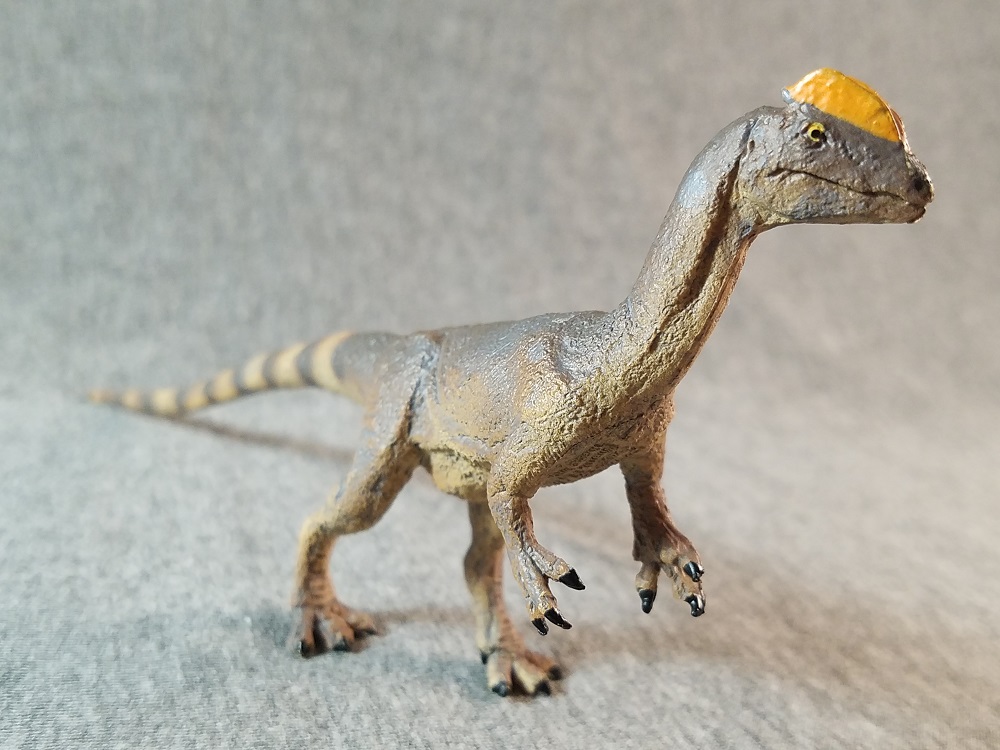
Dilophosaurus has long been depicted as a lithe, graceful animal for its size, and regular Safari sculptor Doug Watson did a reliable job capturing the creature’s sleek physique without making it look scrawny. The figure is a bit small for pronounced muscular detail, but the animal looks very trim, with a few specific details added to the hips and thighs, the neck, and the contours of the belly, where skin folds or tendons might be more pronounced. With the advent of the 2020 paper, this figure could potentially afford to me a little more robust; but by 2000s/2010s standards, this is a fit specimen. One detail of note is the choice to give Dilophosaurus lips instead of exposed teeth. Dilophosaurus often gets depicted in a vicious-looking, snaggle-toothed manner (which I admit is quite attractive), but with growing support in the camp for dinosaurs being lipped, it makes sense to present Dilophosaurus in a more restrained manner here. As an amusing bonus, this also makes the figure’s skull look deeper than usually depicted – which is actually more in line with paleoartist Brian Engh’s skull reconstruction for the 2020 paper.
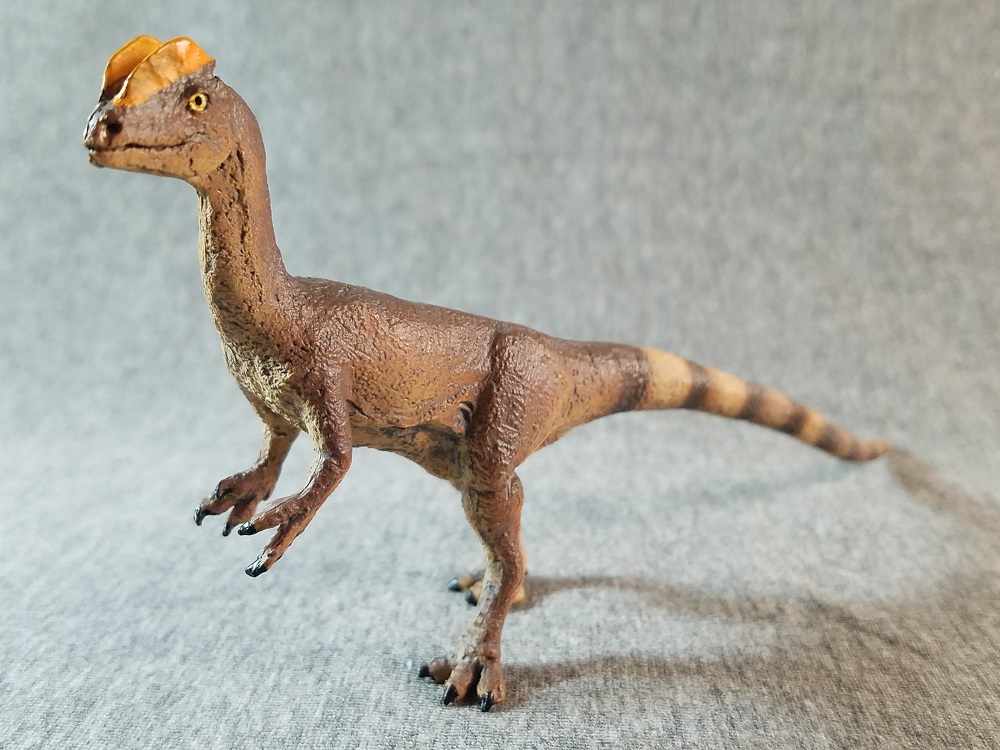
When looking over skeletal illustrations for Dilophosaurus, the skull of the figure does look like it might be a bit small in proportion to the body. The crests are reasonably sized and feature the familiar semicircle shape with a spur behind the eyes. These crests are the feature which are now the most obviously dated in light of the 2020 paper: thorough analysis of known skull material has revealed the crests were an extension of the skull and antorbital fenestrae, rather than just additional bony growths sitting atop the skull. This means the crests could have appeared much more robust and ornate in life, so future Dilophosaurus models may want to take advantage of this and experiment with more elaborate headgear for this Early Jurassic predator.
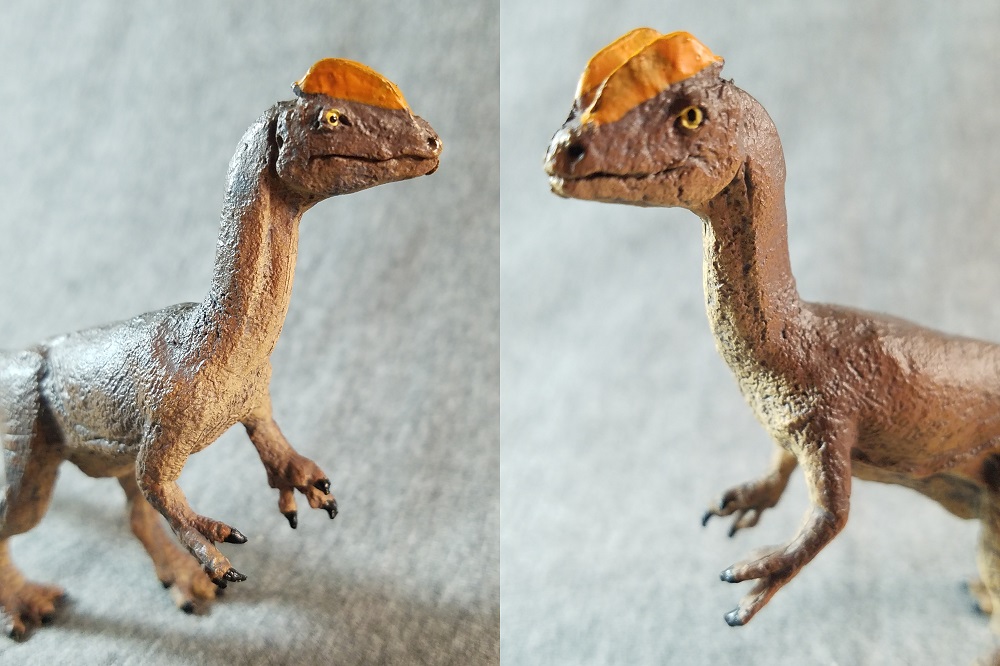
Reviewing the rest of the figure’s body, the anatomical proportions look very good. The figure captures the long neck and torso of the animal, as well as what looks like a generously long tail (my rough measurements seem to match the skeletals, so I think it might be a trick of the eye due to the neck raised up rather than extended forward like I’m used to seeing). The limbs are long and lean, but appear sturdy; the hands each have three large, clawed fingers which look ready to grab something, plus a fourth vestigial finger. The toes are small, but spread out and padded well for support.


Finer details include minute stippling and scaling texture all over the body. The texture varies in subtle ways across different body parts, which helps the figure feel naturalistic. The crests are smoother in texture, while the claws are glossed and just a bit sharp. A grey wash has been applied to further highlight the texturing, done over a conservative color scheme of earthy brown and tan countershading, transitioning to stripes on the tail. I think the grey wash may have been a bit over-applied on my own copy, but in the right lighting, it also looks like there are isolated grey spots along the neck and back, and so it balances out. The claws are straight black, and black highlights are also applied to the mouth line and nostrils. The eyes are simple yellow and the crests are solid bright orange to make them pop from the main body coloration. Although the head of the figure is admittedly pretty small, I think this figure could benefit from a little more quality control, as the paint apps do seem a bit sloppier here. Some additional patterning to the crests might have also been an improvement – although that would require more details for quality control.
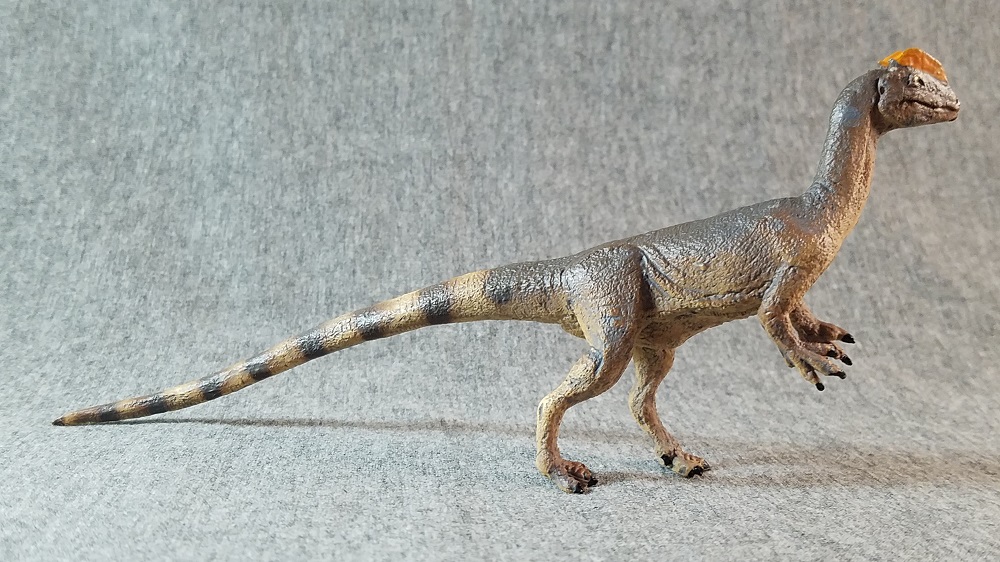
Wild Safari’s 2020 Prehistoric World Dilophosaurus isn’t one of the most stand-out toys on the market, even for its own genus – but it’s an overall solid figure and might honestly be the best representation of the dinosaur as of this writing, at least until more up-to-date figures enter the market (with CollectA leading the charge right now). Even acknowledging that it’s been quickly dated by new studies, this figure should make a pleasant addition to your dino collection. You can, of course, easily purchase the figure directly from Safari’s website, as well as other regular retailers.
Support the Dinosaur Toy Blog by making dino-purchases through these links to Ebay and Amazon. Disclaimer: links to Ebay.com and Amazon.com on the The Dinosaur Toy Blog are often affiliate links, when you make purchases through these links we may make a commission

Old story…from the perspective of an engineer…the body weight at the fulcrum, IE the hips, needs to be evenly distributed front to back–no? As usual, the back portion appears to be too small, too light if you prefer, when compared to the front. Also, the tube-like structure of the torso is more in keeping with a snake than with a creature that evolved into birds. All in all, not very believable, whatever the newest interpretation might be….
I would assume that’s what the tail is for…? Most skeletals depict a small hip area for Dilophosaurus, but then again the 2020 revisions don’t have a full skeletal to their name yet, so maybe that’s another area of anatomy which will be changing.
I appreciate your perspective from an engineering point of view, but keep in mind we are talking about a replica of what was a living, moving creature with muscles that had the ability to alter it’s center of gravity, rather than a static construction that has no such luxury. As for the structure of the torso, Dilophosaurus is arguably not all that closely related to the Dinosaurs that directly led to birds, Tyrannosaurus is far closer and yet has a torso and chest built more like a wine barrel than a bird. Birds are extremely derived and much of their anatomy is directly the result of adaptation to flight.
It is a quite illustrative article of the dilophosaurus from Safari I did not know that this figure was so highly scientific. The bad and that it is commented on this figure that is too small, it deserves to be at a size like the baryonyx of Safari 2021 or daspletosaurus Safari 2021 to give two examples.